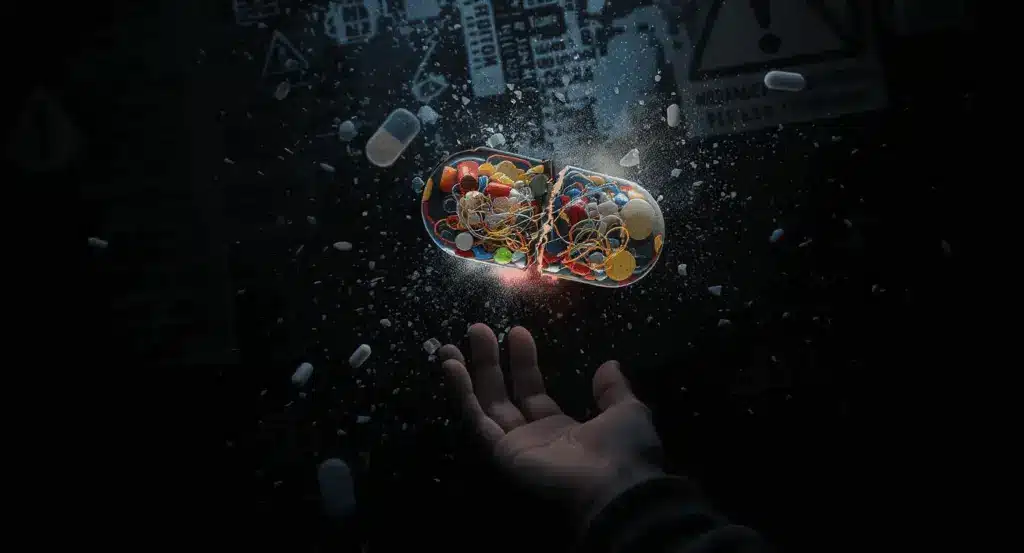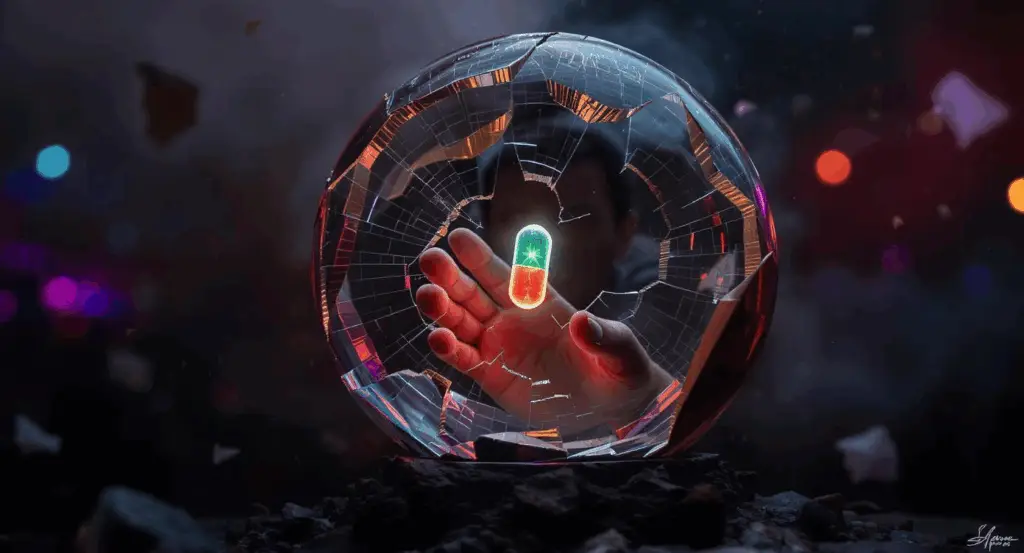ECSTASY
Täydellinen koulutuslähde
Lataa koko Narcononin ekstaasikoulutusesite, josta saat kattavat tiedot.
📄 Lataa täydellinen PDF-esiteTäydellinen koulutusmateriaali Narcononilta
Mitä on riippuvuus?
Kun ihminen on riippuvainen, hän ei hallitse huumeidenkäyttöään, vaan huumeidenkäyttö hallitsee häntä. Kun riippuvainen menettää kykynsä tehdä järkeviä valintoja siitä, käyttääkö hän huumeita vai ei, hän on riippuvainen.
Riippuvuus on tila, jossa henkilö kokee vastustamatonta halua etsiä ja käyttää huumeita tai alkoholia kielteisistä fyysisistä ja psyykkisistä seurauksista huolimatta.
Riippuvuuteen liittyy yleensä fyysinen ja psyykkinen riippuvuus lääkkeestä, ja henkilö kärsii vieroitusoireista, kun lääkkeen käyttöä vähennetään tai se lopetetaan nopeasti.
Narcononin lähestymistapa
Narconon ei usko, että riippuvuus on sairaus, että se on parantumaton tai että ihmisen on "elettävä sen kanssa" loppuelämänsä. Narcononin henkilökunnan ja valmistuneiden kokemuksen mukaan riippuvuudesta on mahdollista toipua täysin ja nauttia tuottavasta, huumeettomasta elämästä.
Ymmärtääksesi riippuvuutta sinun on ensin ymmärrettävä huumeet - mitä ne ovat, niiden käytön merkit ja oireet sekä huumeiden käytön lyhyen ja pitkän aikavälin vaikutukset.
Riippuvaiset kieltävät usein riippuvuutensa.
Mikä on ekstaasi?
EKSTASIA ON SYNTEETTINEN, PSYKOLOGINEN HUUME, jolla on stimuloivia ja hallusinogeenisia ominaisuuksia. Merckin lääkeyhtiö kehitti sen alun perin vuonna 1912. Alkuperäisessä muodossaan se tunnettiin nimellä MDMA.
Tämän päivän ekstaasitodellisuus
Ekstaasista on tullut 1980-luvun lopusta lähtien kattava markkinointitermi huumekauppiaille, jotka myyvät ekstaasin kaltaisia huumeita, jotka itse asiassa saattavat sisältää hyvin vähän tai ei lainkaan MDMA:ta. Vaikka MDMA itsessään voi aiheuttaa haitallisia vaikutuksia, nykyään ekstaasiksi kutsuttu aine voi sisältää monenlaisia aineita - LSD:stä, kokaiinista, heroiinista, amfetamiinista ja metamfetamiinista rotanmyrkkyyn, kofeiiniin, koirien madonpoistolääkkeeseen jne.
Huolimatta diilereiden pillereihin laittamista söpöistä logoista ekstaasin tekee erityisen vaaralliseksi se, että käyttäjä ei koskaan oikeasti tiedä, mitä hän ottaa. Vaarat lisääntyvät, kun käyttäjät lisäävät annosta ja etsivät aiempaa huumaa tietämättä, että he saattavat ottaa aivan toisenlaista huumausaineyhdistelmää.
Mistä ekstaasi tulee?
LÄNSI- EUROOPASSA, pääasiassa Alankomaissa ja Belgiassa, toimivat piilotetut laittomat laboratoriot valmistavat merkittäviä määriä huumausainetta. tabletin, kapselin tai jauheen muodossa. Vaikka valtaosa MDMA:sta tuotetaan Euroopassa, Yhdysvalloissa toimii rajoitettu määrä MDMA-laboratorioita.
Viime vuosina venäläisten järjestäytyneiden rikollisryhmien jäsenet ovat luoneet suhteita länsieurooppalaisiin salakuljettajiin ja saaneet hallintaansa merkittävän osan Euroopan markkinoista. Nämä rikollisjärjestöt ovat tällä hetkellä yhdysvaltalaisten jakeluryhmien ensisijainen lähde.
Ulkomailla MDMA:ta salakuljettavat järjestöt kuljettavat huumausainetta kymmenientuhansien tai useampien tablettien erissä pikapostipalveluiden, kuriirien ja kaupallisten lentoyhtiöiden lennoilla tai viime aikoina lentorahtikuljetuksina useista suurista eurooppalaisista kaupungeista Yhdysvaltojen kaupunkeihin.
Markkinointi ja brändäys
MDMA:n salakuljettajat käyttävät jatkuvasti tuotemerkkejä ja logoja markkinointivälineinä ja erottaakseen tuotteensa kilpailijoiden tuotteista. Logot tuotetaan juhlapyhien tai erityistapahtumien yhteydessä. Suosittuja logoja ovat muun muassa perhoset, salamat ja nelilehtiset apilat.
Miten sitä käytetään
EKSTAASIA KÄYTETÄÄN USEIN YHDESSÄ MUIDEN HUUMEIDEN KANSSA. Sitä nautitaan kuitenkin harvoin alkoholin kanssa, koska alkoholin uskotaan heikentävän sen vaikutuksia. Sitä levitetään useimmiten yökerhoissa, rock-konserteissa ja myöhäisillan juhlissa, joita kutsutaan raveiksi. MDMA:n käyttö ja levitys lisääntyvät, kun rave- ja klubiskene leviää suurkaupunki- ja esikaupunkialueille.
MDMA on useimmiten saatavilla tabletteina, ja se otetaan yleensä suun kautta. Sitä on saatavana myös jauheena, ja sitä nuuskaillaan ja toisinaan poltetaan, mutta harvoin ruiskutetaan. Sen vaikutukset kestävät noin neljästä kuuteen tuntia. Huumeiden käyttäjien mukaan se aiheuttaa syvällisesti positiivisia tunteita, empatiaa muita kohtaan, ahdistuksen poistumista ja äärimmäistä rentoutumista.
MDMA:n sanotaan myös tukahduttavan tarpeen syödä, juoda tai nukkua, minkä ansiosta käyttäjät voivat kestää kahden tai kolmen päivän juhlia. Tämän vuoksi MDMA:n käyttö johtaa joskus vakavaan nestehukkaan tai uupumukseen.
Ekstaasin käytön seuraukset
EKSTAASI TUKAHDUTTAA KEHON ANTAMAT LUONNOLLISET HÄLYTYSSIGNAALIT. Tämän seurauksena lääkkeen ottamisen jälkeen yksilö on vaarassa ylittää fyysiset rajoituksensa ja kestävyytensä. Esimerkiksi ekstaasia käyttävä henkilö ei välttämättä huomaa, että hän on ylikuumentunut ja voi pyörtyä tai jopa kuolla lämpöhalvaukseen.
Texasin yliopiston sosiaalityön tutkimuskeskuksen tekemässä tutkimuksessa todettiin, että ekstaasin yleisimmin raportoituihin pitkäaikaisvaikutuksiin kuuluivat masennus ja keskittymiskyvyn heikkeneminen. Tutkijat havaitsivat myös, että ekstaasin toistuvaan käyttöön liittyi uni-, mieliala- ja ahdistuneisuushäiriöitä, vapinaa tai nykimistä ja muistiongelmia.
Lyhyen aikavälin vaikutukset
- Heikentynyt arvostelukyky
- Väärä kiintymyksen tunne
- Hämmennys
- Masennus
- Unihäiriöt
- Vakava ahdistus
- Paranoia
- Huumeiden himo
- Lihasjännitys
- Huonovointisuus ja vilunväristykset tai turvotus
- Tahaton hampaiden puristus
- Näön hämärtyminen
- Pahoinvointi
Pitkän aikavälin vaikutukset
- Pitkäkestoinen aivovaurio, joka vaikuttaa ajatteluun ja muistiin.
- Vaurio aivojen osissa, jotka säätelevät kriittisiä toimintoja, kuten oppimista, unta ja tunteita.
- On kuin aivojen kytkentäkaappi olisi revitty irti ja kytketty uudelleen väärinpäin.
- Rappeutuneet hermohaarat ja hermopäätteet
- Masennus, ahdistus, muistin menetys
- Munuaisten vajaatoiminta
- Verenvuoto
- Psykoosi
- Sydän- ja verisuonitautien romahtaminen
- Kouristukset
- Kuolema
Katujen nimet
Ekstaasin käytön vaikutukset
Vaikka EKSTASIAN LYHYTAIKAISET VAIKUTUKSET saattavat vaikuttaa joistakin naiiveista käyttäjistä hauskalta, huume tekee tuhoisaa työtä heti ensimmäisestä nauttimisesta lähtien. Yllättävän paljon vahinkoa voi kertyä nopeasti, mukaan lukien tietysti riippuvuus. Jotkut ihmiset tulevat riippuvaisiksi ekstaasista varsin nopeasti. Himo käyttää lisää ekstaasia voi ajaa henkilön takaisin käyttämään sitä yhä uudelleen ja uudelleen, vaikka hän tajuaa, kuinka paljon se vahingoittaa häntä. Eräässä tutkimuksessa kävi ilmi, että lähes puolet nuorista, jotka ilmoittivat käyttävänsä ekstaasia, osoittivat myös merkkejä riippuvuudesta.
Vaikeampaa on nähdä, että ekstaasin käytöstä aiheutuu pysyviä psykologisia haittoja. Viimeaikaiset tutkimukset ovat osoittaneet, että lyhytkin altistuminen voi aiheuttaa useita viikkoja kestäviä ongelmia, kuten muistin menetystä, oppimisvaikeuksia, sekavuutta, ahdistuneisuutta ja masennusta. Raskas käyttäjä voi kokea myös vainoharhaisuutta ja uniongelmia.
Kykenemättömyys tuntea nautintoa
Vaikka huumeiden käytön syynä ovat käyttäjien nautinnollisina pitämät tuntemukset, on ironista, että yksi ekstaasin käytön vaikutuksista on se, että se estää henkilöä tuntemasta mielihyvää normaaleista tapahtumista. Tämä voi edistää riippuvuutta, koska henkilö tuntee itsensä masentuneeksi ja onnettomaksi, kun hän ei ole pilvessä.
Jos ekstaasia käytetään toistuvasti lyhyen ajan sisällä, haitalliset vaikutukset voivat olla jopa vakavampia kuin silloin, kun sitä käytetään vain satunnaisesti. On tavallista, että tanssibileisiin osallistujat ottavat useita pillereitä kerralla tai ottavat pillerin toisensa jälkeen pitääkseen tunteen yllä.
Kuvitteellinen rakkauspilleri
EKSTASIAA KUTSUTTAAN usein rakkauspilleriksi, koska se tehostaa väri- ja äänihavaintoja ja oletettavasti vahvistaa tuntemuksia, kun henkilö koskettaa tai hyväilee toista, erityisesti seksin aikana.
Ekstaasi sisältää kuitenkin usein hallusinogeeneja, huumeita, jotka vaikuttavat mieleen ja saavat ihmiset näkemään tai tuntemaan asioita, joita ei oikeasti ole olemassa. Hallusinogeenit voivat heittää ihmisen pelottavaan tai surulliseen kokemukseen menneisyydestä, johon hän jää jumiin huomaamattaan.
Mielikuva ekstaasista rakkauspillerinä on yksi monista valheista, joita huumeesta levitetään.
Ekstaasi on emotionaalisesti vahingollista, ja käyttäjät kärsivät usein masennuksesta, sekavuudesta, vakavasta ahdistuksesta, vainoharhaisuudesta, psykoottisesta käyttäytymisestä ja muista psykologisista ongelmista.
Suosittelu - Megan
"Onneksi olen elossa, mutta trauman jälkeiset päivät, kuukaudet ja vuodet ovat jääneet jäljelle. Minun on käsiteltävä sitä, mitä se on tehnyt minulle koko elämäni ajan. Olen kokenut kaikkea - mitä tahansa. Masennus, ahdistus, stressi, [toistuvat] painajaiset ja paha päänsärky olivat muutamia asioita, jotka vaikuttivat minuun sen jälkeen, kun otin ekstaasia. Olin melkein kuolla. Siihen tarvittiin vain yksi yö, muutama [ekstaasi]pilleri ja alkoholin juominen. Tämä huume on hyvin kohtalokas, ja olen niin kiitollinen, että olen elossa. En voi kuvailla, kuinka vaikeaa on selviytyä näistä painajaisista koko ajan. Herään hikisenä, kiitän vain Jumalaa ja olen niin kiitollinen, että se on vain yksi painajainen. Rukoilen, että ajan myötä painajaiset katoavat. Mikään huume ei ole rullan tai huuman arvoinen."-Megan
Ekstaasin käytön tunnistaminen
ECSTASY ON VAHVA STIMULANTTI, joka on usein pieninä valkoisina tai värillisinä pillereinä, joihin on leimattu logoja tai sanoja. Käyttäjillä voi olla tikkareita tai tutteja, jotka auttavat lääkkeen aiheuttamien puristettujen leukalihasten kanssa.
Tieteelliset tiedot
Nämä ekstaasia koskevat tosiasiat on saatu monissa tutkimuksissa.
- Ekstaasin käyttö voi aiheuttaa maksan vajaatoimintaa, kuten 14-vuotias tyttö, joka kuoli siihen, vaikka lääkärit yrittivät pelastaa hänet maksansiirrolla.
- Ekstaasia sekoitetaan joskus rotanmyrkyn kaltaisiin aineisiin.
- Nuoret ihmiset ovat kuolleet nestehukkaan, uupumukseen ja sydänkohtaukseen, kun he ovat ottaneet liikaa ekstaasia.
- Ekstaasi voi aiheuttaa munuais-, maksa- ja aivovaurioita, mukaan lukien pitkäaikaisia vaurioita aivokudoksessa.
- Pienikin määrä ekstaasia voi olla niin myrkyllistä, että se voi myrkyttää hermoston ja aiheuttaa korjaamattomia vaurioita.
Aiheuttaako ekstaasi riippuvuutta?
National Institute on Drug Abuse -laitoksen mukaan. Nämä käyttäjät ovat tietoisia huumeiden vaaroista, mutta koska he ovat fyysisesti ja psyykkisesti riippuvaisia huumeista, he eivät pysty lopettamaan niiden käyttöä. Psykologinen riippuvuus johtuu siitä, että henkilö tottuu sen aiheuttamien hormonien vapautumisen vaikutuksiin ja haluaa niitä yhä enemmän. Tämä psykologinen riippuvuus synnyttää sitten fyysisen riippuvuuden, jossa aivot itse tottuvat ekstaasin tuottamaan kemialliseen reaktioon, jolloin henkilö ei pysty toimimaan ilman usein toistuvia ekstaasiannoksia.
Mutta vaikka käyttäjä ei jäisikään riippuvaiseksi, seuraavat hyvin todelliset vaarat ovat olemassa:
VAARA NRO. 1
Vuoteen 1995 mennessä alle kymmenen prosenttia markkinoilla olleista ekstaasipillereistä oli puhdasta MDMA:ta. Nykypäivän ekstaasin käyttäjä käyttää yleensä sekoitusta monista eri huumeista ja usein myrkyllisistä aineista.
VAARA NRO. 2
Henkilön on jatkuvasti lisättävä ottamansa lääkkeen määrää, jotta hän voi tuntea samat vaikutukset. Käyttäjien mukaan ekstaasin vaikutus vähenee huomattavasti ensimmäisen annoksen jälkeen. Ja kun henkilö ottaa enemmän huumetta, myös kielteiset vaikutukset lisääntyvät. Koska huumeen käytön toivottu vaikutus vähenee, henkilö kokeilee usein sen jälkeen muita huumeita, jotka ovat vielä vaarallisempia.
VAARA NRO. 3
Käyttäjät kokevat, että joskus on tarpeen käyttää muita huumeita, kuten heroiinia tai kokaiinia, jotta he selviytyisivät psyykkisestä ja fyysisestä kivusta, joka aiheutuu ekstaasin lopettamisen jälkeen. 92 prosenttia ekstaasia käyttävistä käyttää myös muita, jopa kovempia huumeita.
VAARA NRO. 4
Väärä käsitys siitä, että ihminen voi hyvin vain ekstaasin avulla, johtaa siihen, että sitä halutaan ottaa useammin kuin vain raveissa ja teknobileissä. Kuten muidenkin stimuloivien huumeiden kohdalla, ihmiset jatkavat ekstaasin käyttöä epämiellyttävistä vaikutuksista huolimatta.
Suosittelut - Liz ja Ann
"Eräässä rave-bileessä näin erään kaverin, joka oli tunkenut itseensä ekstaasia ja toisteli tuntikausia: 'Olen appelsiini Älä kuori minua'. Olen appelsiini, älä kuori minua.' Toinen kaveri luuli olevansa kärpänen eikä lopettanut päänsä lyömistä ikkunaan."-Liz
"Ekstaasi teki minut hulluksi. Eräänä päivänä purin lasia, aivan kuin olisin purrut omenaa. Minun piti saada suuni täyteen lasinsiruja tajutakseni, mitä minulle tapahtui. Toisella kerralla revin rättejä hampaillani tunnin ajan."-Ann
Molly: Molly: Toinen ekstaasin muoto
MOLLY (LYHENNE SANOISTA MOLECULE) ON LEMPINIMI ERÄÄLLE EKSTAASIN MUODOLLE. Sitä mainostetaan MDMA:n (ekstaasin) puhtaana kiteisenä muotona, vaikka se saattaa sisältää myös muita huumausaineita. Kesällä 2013 muutama tunnettu laulaja viittasi huumeeseen joko laulujen sanoituksissa tai lavalta käsin. Kun kahden ihmisen epäiltiin kuolleen käytettyään Mollya New Yorkissa järjestetyillä musiikkifestivaaleilla, tämä huume nousi yhtäkkiä valokeilaan. Musiikkifestivaalin viimeinen päivä peruttiin huolen vuoksi siellä käytetyistä huumeista.
MDMA:ta missä tahansa muodossa käyttävä henkilö on vaarassa kuolla ylikuumenemiseen. MDMA on voimakas stimulantti, joka nostaa sykettä ja kehon lämpötilaa. Yökerhoympäristössä käyttäjillä on usein käytössään jäähdyttelyhuone, jossa on runsaasti kylmää vettä myynnissä.
He voivat jäähtyä ennen kuin he palaavat tanssimaan ylikuumenemisen estämiseksi. Mutta kesäaikaan ulkoilmassa henkilö ei välttämättä pysty pitämään ruumiinlämpöään alhaalla.
Molly-annos kestää neljästä kuuteen tuntia, mikä saattaa johtaa siihen, että jotkut juhlijat tai festivaalien osanottajat ottavat toistuvasti uusia annoksia.
Mollyn käytön tunnistaminen
NIGHTCLUBS, MUSIIKKIFESTIVAALIT JA MUUT MUSIIKKITILAT näyttävät olevan huumausaineiden käyttöön räätälöityjä. Tällaisessa ympäristössä jopa henkilö, joka ei normaalisti käytä huumeita, saattaa sortua käyttämään niitä, koska kaikki hänen ympärillään näyttävät pitävän hauskaa. Mutta näillä vahvoilla piristeillä ja psykedeelisillä huumeilla on tuhoisia vaikutuksia joihinkin ihmisiin.
Molly on voimakas stimulantti, joka nostaa ruumiinlämpöä ja saa sydämen lyömään nopeammin. Reaktio tähän stimulaatioon voi olla kouristukset, korkea kuume, elinten hajoaminen ja kuolema.
Yksi nuori nainen piti herättää henkiin kahdesti. Hänen pulssinsa oli yhdessä vaiheessa 165 lyöntiä minuutissa ja hänen lämpötilansa oli 108 astetta. Vakavat fyysiset ja henkiset haitat voivat olla seurausta siitä, että yritettiin vain juhlia yön yli.
Suosittelu - Lynn
"Kuulen monien ihmisten puhuvan ekstaasista ja kutsuvan sitä hauskaksi ja harmittomaksi huumeeksi. Voin vain ajatella: 'Jos he vain tietäisivät.' Viidessä kuukaudessa muutuin jokseenkin vastuullisesti elävästä ja unelmaani tavoittelevasta ihmisestä ihmiseksi, joka ei välittänyt mistään - ja mitä korkeammalle pääsin, sitä syvemmälle vajosin pimeään, yksinäiseen paikkaan. Kun nukuin, näin painajaisia ja tärisin. Ihoni oli tahrainen, päässäni jyskytti ja aloin tuntea oloni vainoharhaiseksi, mutta en välittänyt siitä kaikesta, koska ajattelin sen olevan normaalia. Kunnes sinä yönä luulin kuolevani. Ekstaasi vei voimani, motivaationi, unelmani, ystäväni, asuntoni, rahani ja ennen kaikkea järkeni. Olen huolissani tulevaisuudestani ja terveydestäni joka päivä. Edessäni on monia vuoria, mutta aion jatkaa kiipeämistä, koska olen yksi onnekkaista."-Lynn
Riippuvuus ja riskikäyttäytyminen
MDMA ON joidenkin ihmisten mielestä ADDIKTIIVINEN ensimmäisillä käyttökerroilla. Toiset ihmiset, jotka käyttävät sitä vain viikonloppuisin juhliakseen, saattavat pian joutua käyttämään sitä myös viikolla, koska muutama päivä myöhemmin ilmenee murskaava masennus. Tällainen käyttäytyminen muuttuu nopeasti täysimittaiseksi riippuvuudeksi.
MDMA:ta tai Mollya käyttävä henkilö saattaa käyttää huonoa harkintakykyä seksuaalisissa kohtaamisissa. Huumeen synnyttämän keinotekoisen empatian tunteen vuoksi jotkut miehet antavat klubeilla tai musiikkifestivaaleilla huumetta naisille, jotta naiset tuntisivat rakastavansa heitä ja haluaisivat harrastaa seksiä heidän kanssaan. Tämä tunne on poissa seuraavana päivänä, mutta jos nainen jää koukkuun, häntä ajetaan toistamaan tämä käytös.
Kuten mikä tahansa riippuvuus, pakkomielle hankkia Mollya ja käyttää sitä väärin vetää ihmisen koko elämän alaspäin. Hän todennäköisesti hylkää mielenkiinnon kohteet ja tavoitteet ja etsii niiden sijaan lisää huumeita.
Mitä huumeet ovat?
LÄÄKKEET OVAT POHJIMMILTAAN MYRKKYJÄ. Vaikutus riippuu otetusta määrästä.
Pieni määrä toimii stimulanttina (nopeuttaa toimintaa). Suurempi määrä toimii rauhoittavana aineena (hidastaa sinua). Vielä suurempi määrä myrkyttää ja voi tappaa.
Tämä pätee kaikkiin lääkkeisiin. Vain vaikutuksen aikaansaamiseksi tarvittava määrä on erilainen.
Monilla lääkkeillä on kuitenkin toinenkin ongelma: ne vaikuttavat suoraan mieleen. Ne voivat vääristää käyttäjän käsitystä siitä, mitä hänen ympärillään tapahtuu. Tämän seurauksena henkilön toiminta voi olla outoa, järjetöntä, sopimatonta ja jopa tuhoisaa.
Huumeet estävät myös kaikki aistimukset, niin toivotut kuin ei-toivotutkin. Vaikka ne siis lievittävät kipua lyhytaikaisesti, ne myös hävittävät kyvyn ja valppauden ja hämärtävät ihmisen ajattelua.
Lääkkeet ovat lääkkeitä, joiden tarkoituksena on saada kehosi toimimaan paremmin nopeuttamalla, hidastamalla tai muuttamalla jotakin kehon toimintatapaa. Joskus ne ovat välttämättömiä. Lääkkeet ovat kuitenkin edelleen huumeita: ne toimivat piristävinä tai rauhoittavina aineina, ja liikaa niitä voi tappaa sinut. Jos lääkkeitä käytetään väärin, ne voivat olla yhtä vaarallisia kuin laittomat huumeet.
Tietoa Narcononista
NARCONON (tarkoittaen "NO NARCOTICS") -huume- ja alkoholikuntoutusohjelma on avoin kaikille, jotka haluavat lopettaa riippuvuutensa ja elää tuottavaa, huumeetonta elämää. Narconon-ohjelmassa ei ainoastaan käsitellä huumeiden väärinkäytön heikentäviä vaikutuksia mieleen ja kehoon, vaan siinä autetaan myös selvittämään, miksi henkilö ylipäätään kääntyi huumeiden puoleen. Tämän tuloksena kymmenet tuhannet ihmiset ovat päässeet Narconon-ohjelmasta uuteen, huumeidenkäytöstä vapaaseen elämään.
Huumekuntoutuksen lisäksi Narcononin huumeidenkäytön ehkäisytyöntekijät ovat valistaneet miljoonia koululaisia. Narcononilla on yli viidenkymmenen vuoden kokemus huumekasvatuksesta, ja se on todistetusti ollut tehokas keino pitää nuoret erossa huumeista.
Sanasto
Täydellinen koulutuslähde
Lataa koko Narcononin ekstaasikoulutusesite, josta saat kattavat tiedot.
📄 Lataa täydellinen PDF-esiteTäydellinen koulutusmateriaali Narcononilta
Tutustu muihin ekstaasia käsitteleviin opetusartikkeleihin
MDMA:n piilotetut riskit festivaaleilla
Mistä ekstaasi todella koostuu?
Miksi ekstaasi ei ole niin turvallista kuin ihmiset luulevat
Usein kysytyt kysymykset ekstaasista - mitä sinun tarvitsee tietää
Mikä on ekstaasi ja mitä se tekee?
Ekstaasi on kadunnimi MDMA:lle, synteettiselle huumausaineelle, joka muuttaa mielialaa ja havaintokykyä. Se luo vääränlaisen yhteenkuuluvuuden ja euforian tunteen, jota seuraa usein sekavuus, ahdistus tai väsymys.
Voiko ekstaasi olla vaarallista, vaikka sitä käytettäisiin vain kerran?
Kyllä. Yksikin pilleri voi aiheuttaa vakavia terveysongelmia, kuten nestehukkaa, ylikuumenemista, sydänongelmia tai paniikkia. Riskit ovat suuremmat tungoksessa, kuten klubeilla tai festivaaleilla.
Ovatko ekstaasipillerit aina MDMA:ta?
Monet ekstaasina myytävät pillerit sisältävät muita aineita, kuten amfetamiinia, kofeiinia tai jopa myrkyllisiä kemikaaleja, kuten PMMA:ta tai synteettisiä stimulantteja. Tämä tekee niiden vaikutuksista arvaamattomia ja vaarallisempia.
Mitkä ovat ekstaasin käytön lyhytaikaiset vaikutukset?
Käyttäjät voivat tuntea olonsa energiseksi, emotionaalisesti avoimeksi ja herkäksi äänille ja kosketukselle. Näitä vaikutuksia seuraa kuitenkin usein sekavuus, ahdistuneisuus, uniongelmat ja tunnekuohu.
Mitkä ovat ekstaasin käytön pitkän aikavälin riskit?
Toistuva käyttö voi johtaa emotionaaliseen epävakauteen, muistiongelmiin, keskittymisvaikeuksiin ja riippuvuuteen huumeista, jotta voi nauttia sosiaalisista tilanteista tai tuntea yhteyttä.
Voiko ekstaasista tulla riippuvainen?
Kyllä. Vaikka ekstaasi ei ehkä aiheuta fyysistä vieroitusoireita kuten jotkin huumeet, käyttäjät voivat tulla psykologisesti riippuvaisiksi sen vaikutuksista ja tuntea, etteivät he pysty toimimaan sosiaalisesti ilman sitä.
Mitä minun pitäisi tehdä, jos joku tuttavani käyttää ekstaasia säännöllisesti?
Aloita tiedottamalla itsellesi. Puhu sitten heille tuomitsematta ja tarjoa todellisia ratkaisuja. Narcononin kaltainen kuntoutusohjelma voi auttaa heitä vapautumaan ilman korvaavia huumeita.
Miten Narconon auttaa ekstaasia käyttäviä ihmisiä?
Narconon tarjoaa ainutlaatuisen, huumeettoman lähestymistavan toipumiseen. Vieroitushoidon, elämäntaitokoulutuksen ja täydellisen kuntoutuksen avulla yksilöt voivat saada takaisin selkeyden, vastuullisuuden ja huumeista vapaan tulevaisuuden.



